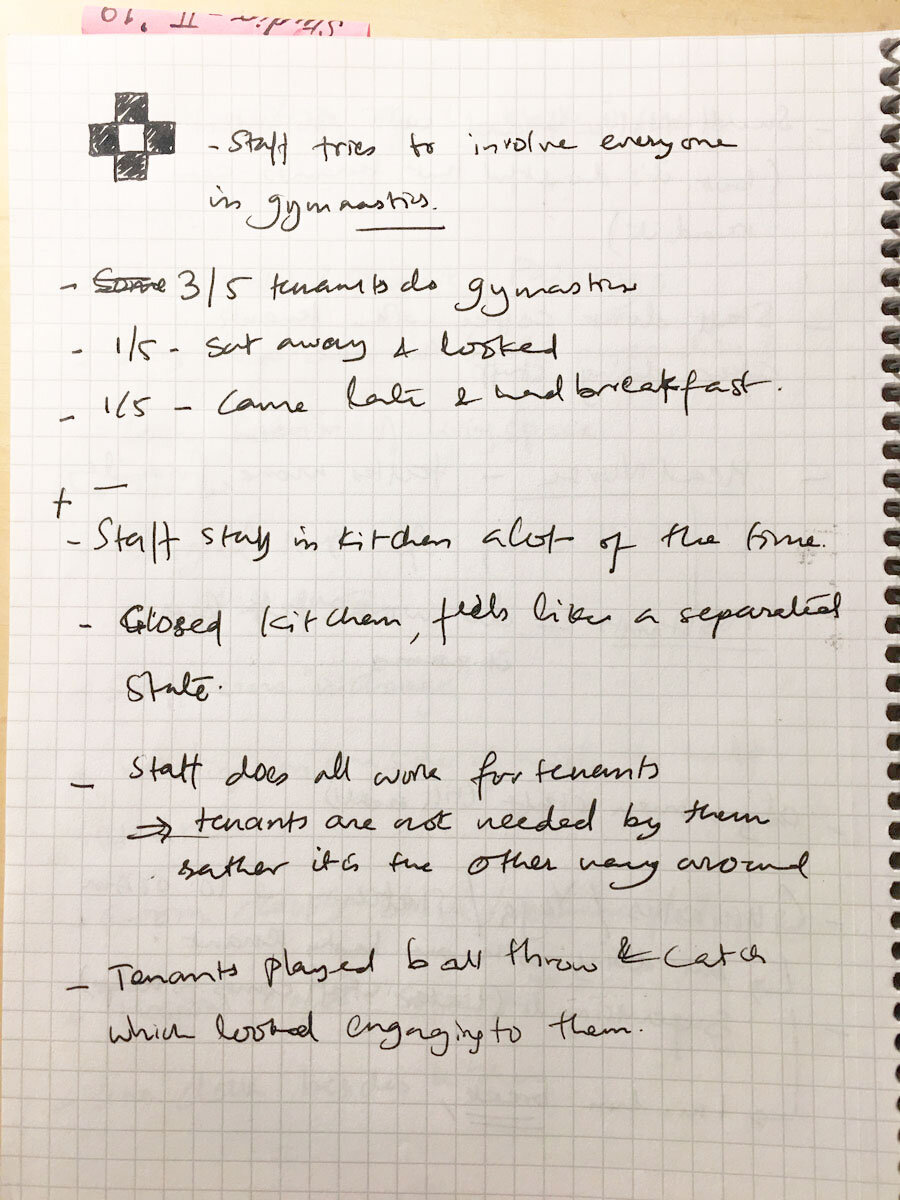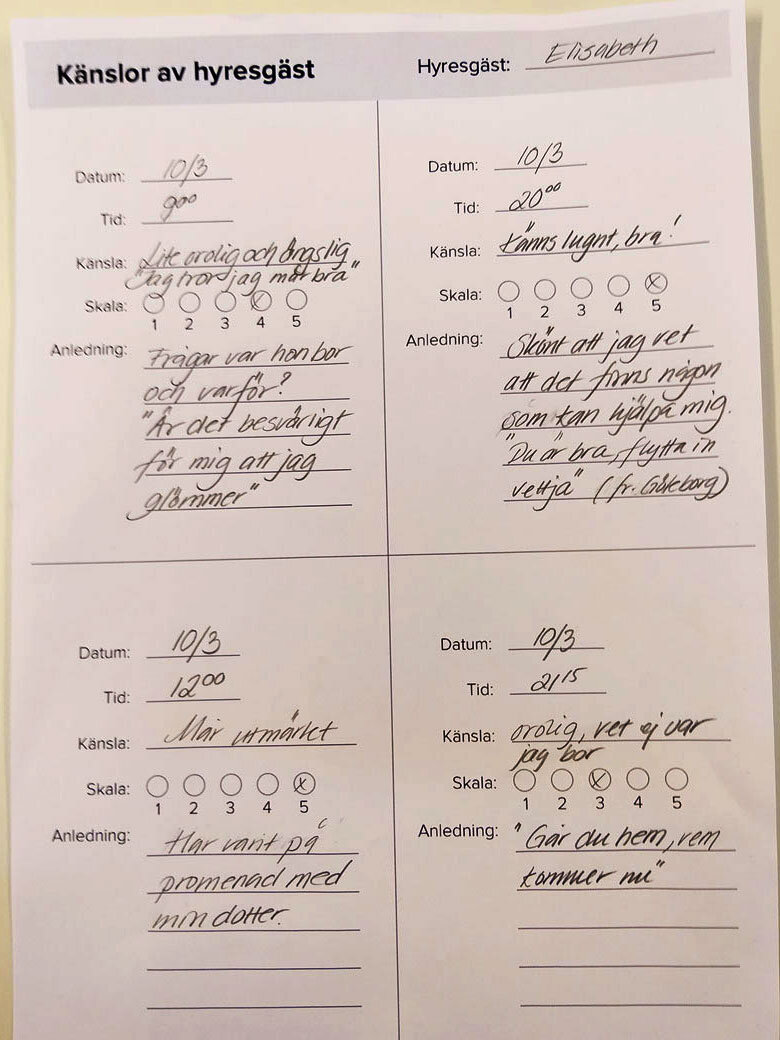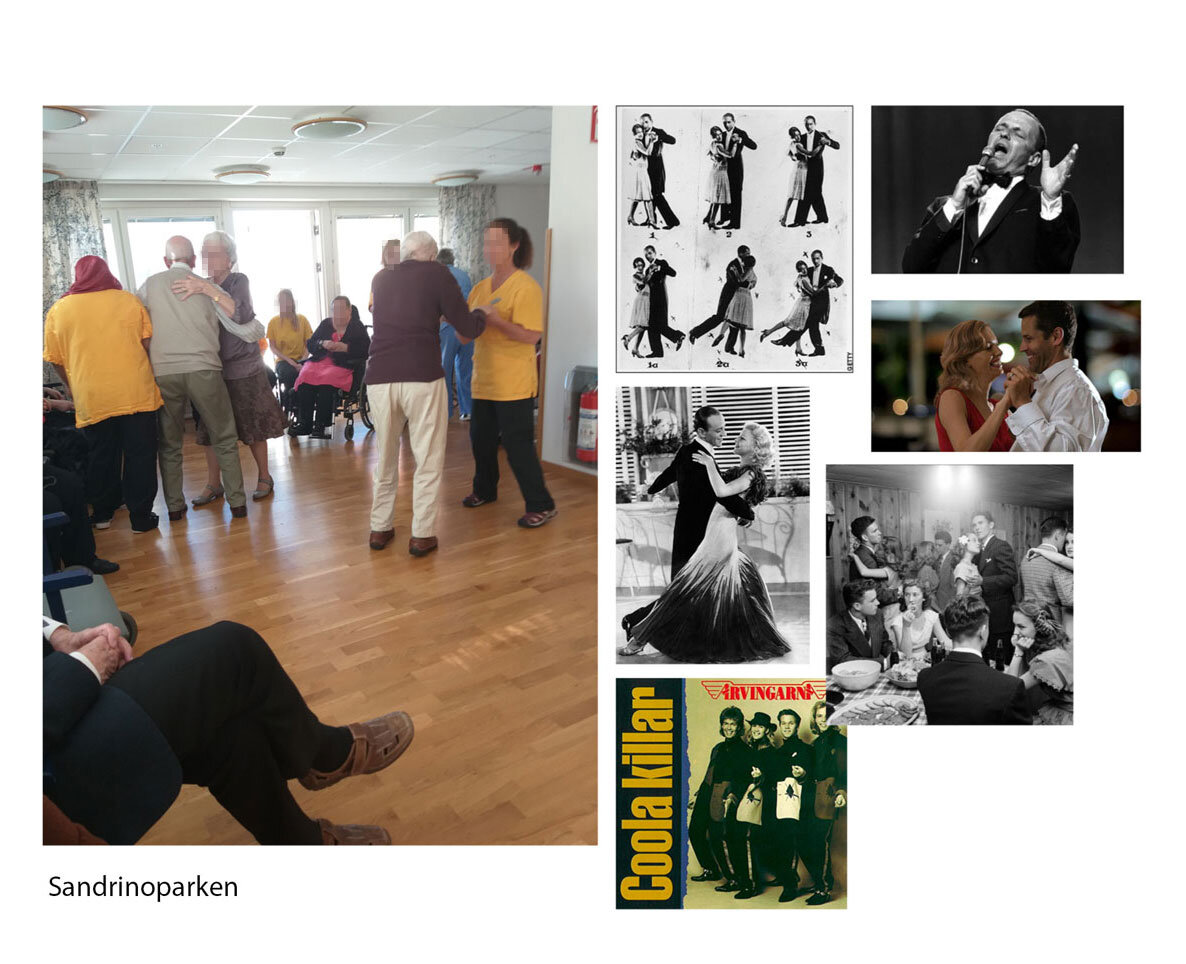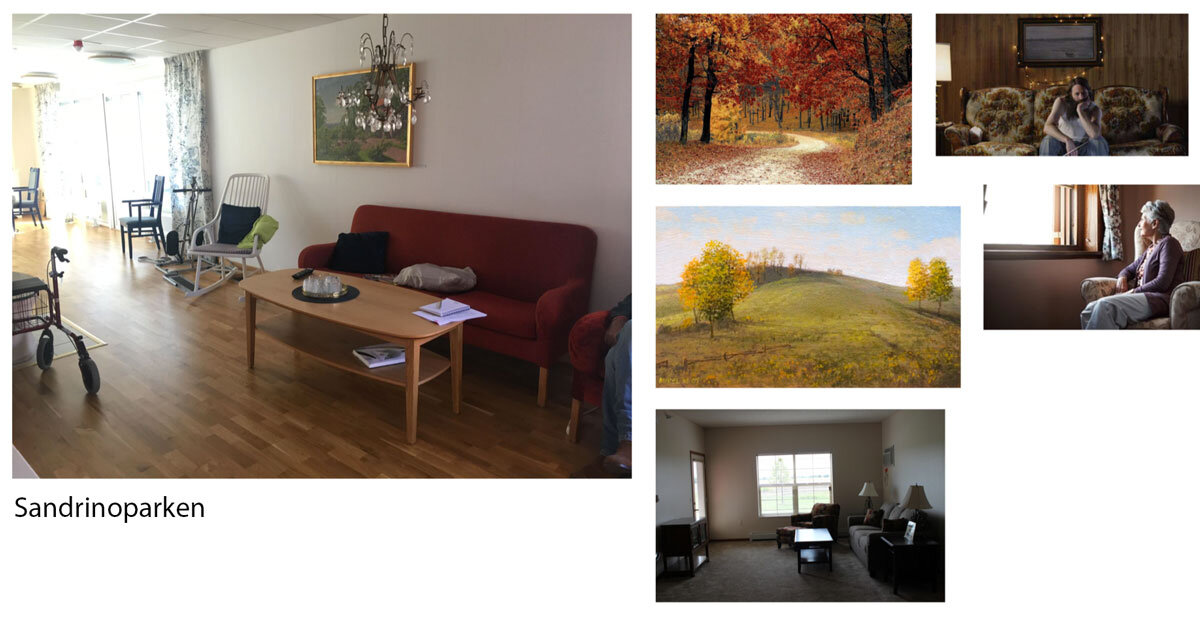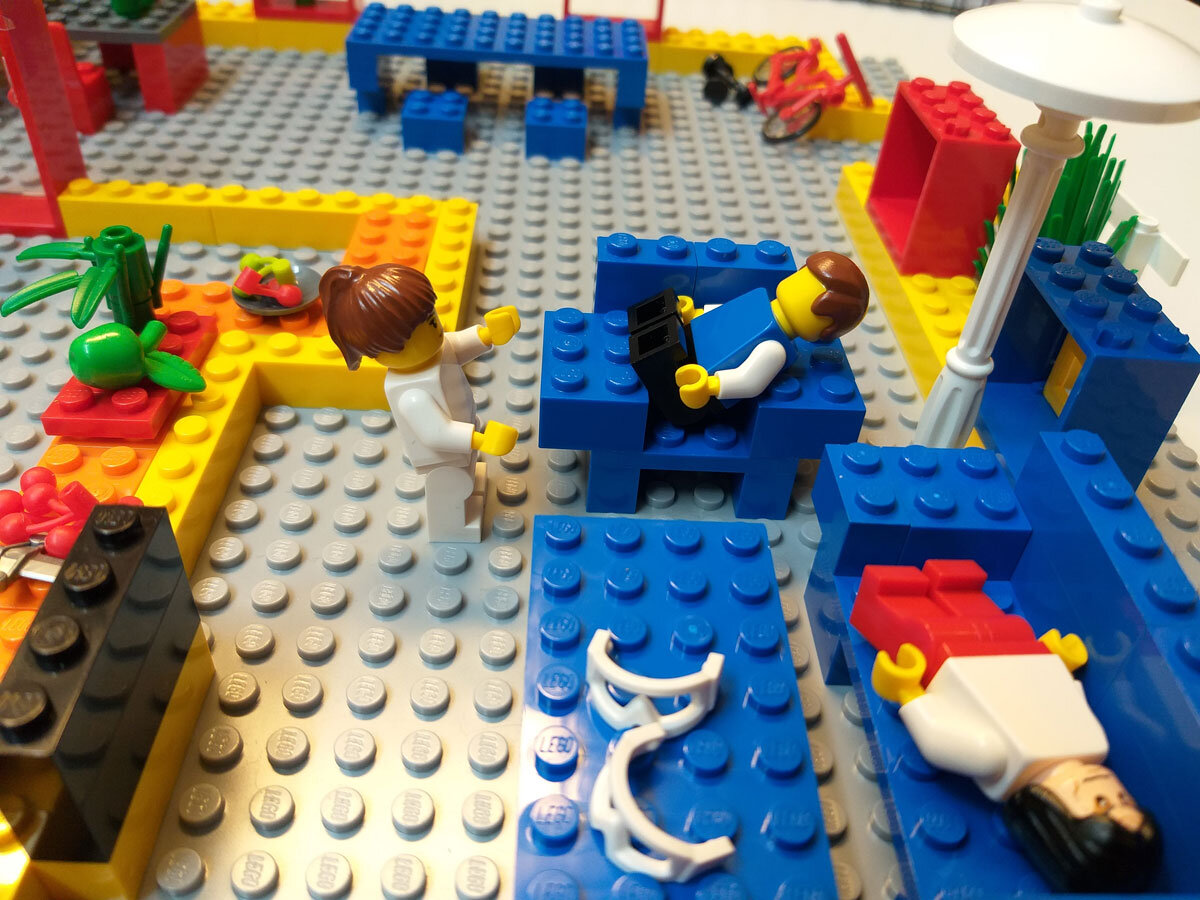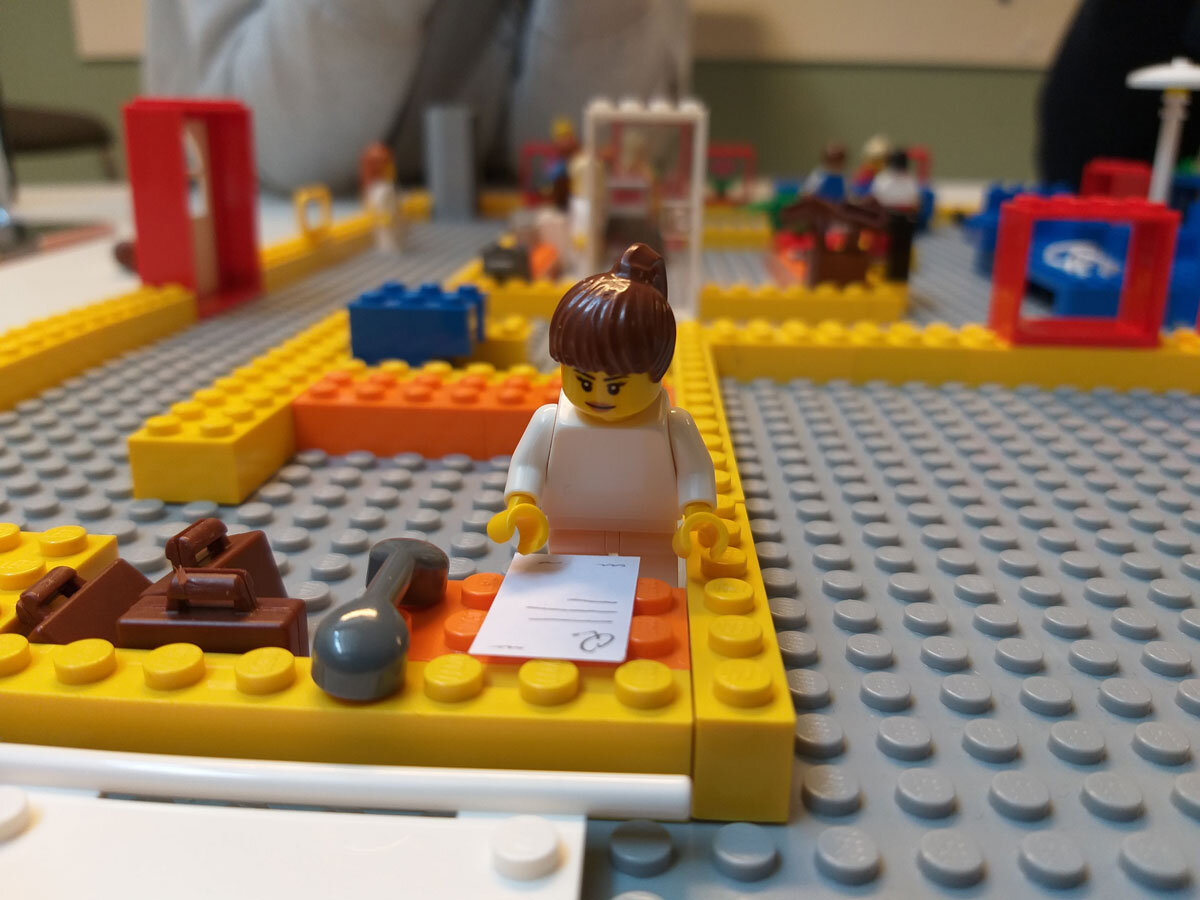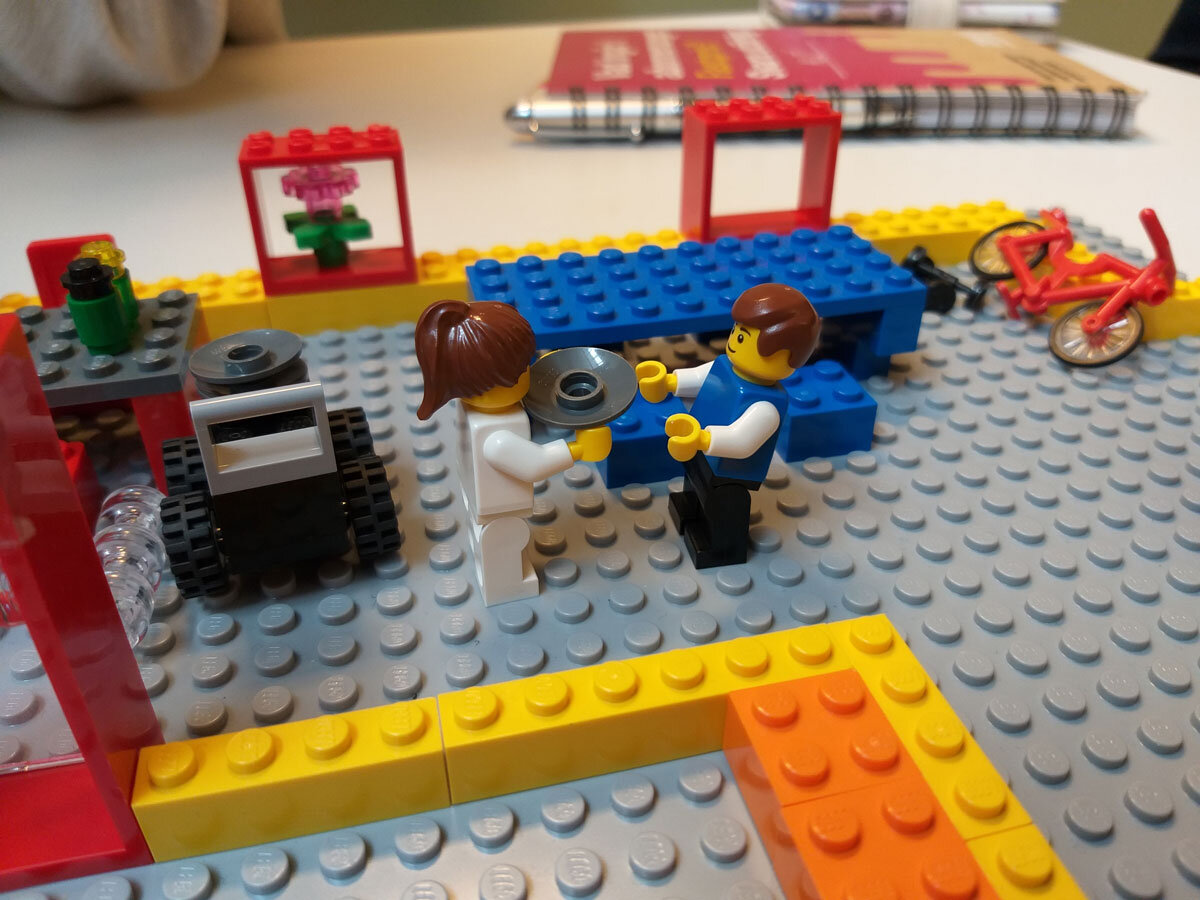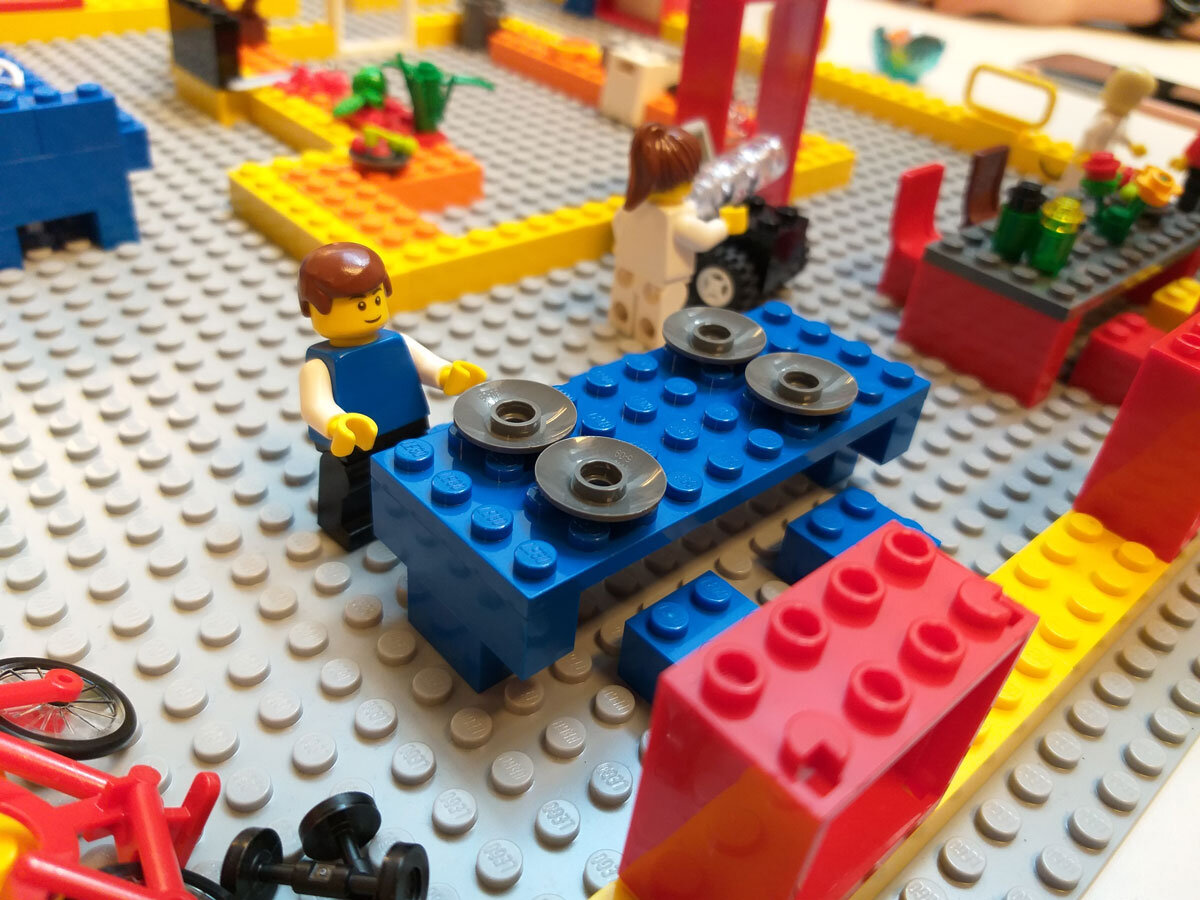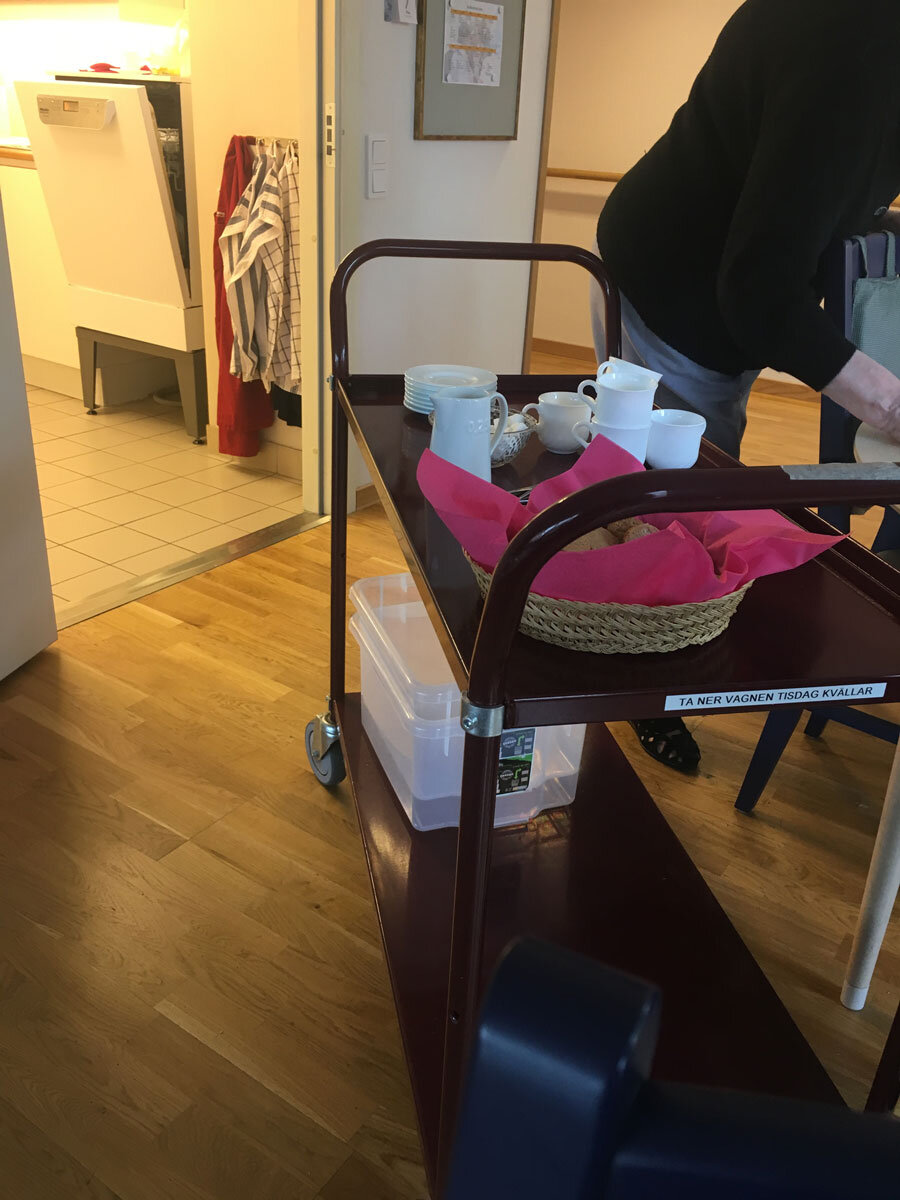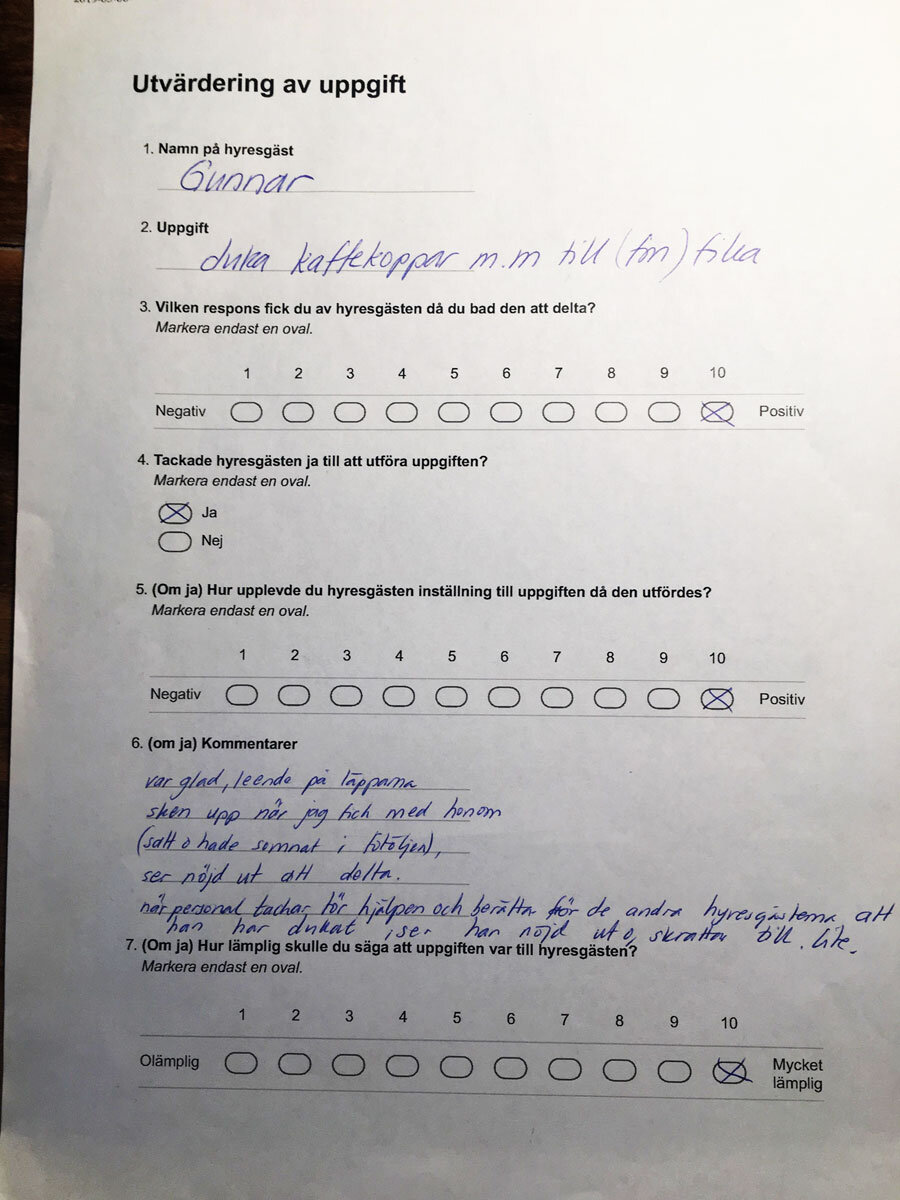Breaking Loneliness
@Linköping University (Sweden) | Master's Programme, Spring 2019
1. Introduction
The aim of this project was to design a solution that can reduce loneliness among elderly patients with dementia. We worked with a local municipal organisation — Sandrinoparken, which is a newly built accommodation in central Linköping for elderly people with dementia.
This was a university project done in spring 2019 with 4 other students. My teammates were — Douglas Driving, Lisa Nittfors, Emma Hansson and Afina Zahra.
1.1 The facility
The housing facility is run by a team of caretakers and helpers who work full time to support the patients (who are referred to as tenants by the caretakers). There are five floors with ten apartments per floor. On two floors there are double apartments. After patients are diagnosed with dementia, some decide to move to such facilities as a way to better manage the disease and get the support they need which might be hard to get at home.
Sandrinoparken (Linköping, Sweden) — Living facility for patients with dementia
1.2 Our assignment
A Swedish health survey among elderly with dementia showed that 58% complained about loneliness and about 39% were not happy with the range of activities offered. The university had collaborated with the Sandrinoparken facility and our task was to work with them over the period of a semester to understand and propose a solution for these problems. This assignment was a major part of our spring design studio course which focuses on service design.
2. Research
2.1 The challenge
The Alzheimer's Association (alz.org) defines dementia as "an overall term for diseases and conditions characterized by a decline in memory, language, problem-solving and other thinking skills that affect a person's ability to perform everyday activities."
The disease itself poses a challenge as to how a designer interacts with the user and understands user needs. Many research methods rely on the user being able to recall past experiences and think of those experiences to give the designer valuable insights. But in our case the impaired memory and thinking skills of the user posed a major challenge and made us work differently.
... in our case the impaired memory and cognitive abilities of the user posed a major challenge ...
For these reasons we relied a lot on observations and interviewing the caretakers, assistant nurses, operations managers and other actors to gain key insights into the tenants' lives.
2.2 Observations
We decided that the first task would be to conduct onsite observations and get a first hand view of what a day in their life looks like. The tenants (dementia patients will be referred to as tenants) had a daily schedule which was overseen by the caretakers throughout. All the team members went to the Sandrinoparken facility in groups of two and first introduced ourselves to the tenants and then tried to blend in and just observe the happenings of the day. We noted down everything which could be of interest to us, including their daily activities, their interaction with the caretakers, layout of the facility, the relationships between each other, as well as many other details.
Above: Notes taken during observation session at Sandrinoparken.
The groups later met and discussed what they saw and what first information abstractions can be drawn from our observations. Having us go in different groups gave us a wider range of events to observe and we were able to validate some common observations independently as well as discuss on our differences.
2.3 Interviews with caretakers
The observations gave us a preliminary but intimate insight into the lives of the user — the tenants. That was a great way for us to develop relevant questions for the caretakers and other facility operators. These actors were involved in taking care of the tenants daily and held key insights and answers for us. We created a set of questions which would answer the group's shared enquiries. Later, two of our Swedish speaking teammates met with the caretakers and had a candid interview session. We tried to ask several caretakers the same questions to triangulate and validate some insights if possible. There were several interesting details which we got to know from these questions. For e.g. One caretaker told us that they have put mirrors inside the tenants' apartments because sometimes the tenants don't remember that they are old.
...they have put mirrors inside the tenants' apartments because sometimes the tenants don't remember that they are old.
We did not limit the interviews to only the caretakers. We also interviews the facility deputy manager who was responsible for recruiting, staff meetings, structuring budget and resources, etc. Interviewing her let us know, among other things, a lot about the process that happens when a new tenant moves in — how they handle the change, how their family adapts to the new situation.
2.4 Feelings Survey
From these interviews we gained a lot of valuable knowledge which we would be using in developing our concepts but we were still not satisfied by just getting the point of view of the caretakers. We wanted to somehow get to know how the tenants themselves feel. Upon asking the facility if we could interview the tenants, we were informed that since we are unfamiliar people it might scare and make the tenants stressed. So we adapted to the situation and devised an indirect way to get some insight into the tenants — our idea was a feelings survey which would be filled multiple times every day by the caretakers. The caretakers would go to the tenant and ask them a couple of questions, and fill in their answers in the form. We let this experimental data collection go on for a couple of days and later met up with the caretakers to gather the surveys.
Above: Filled out survey forms by the caretakers
The survey provided some more insights into the lives of tenants. The tenants talked about their physical ailments as well as stressors. It also told us the nature of the disease — how some tenants get anxious when they forget where they are. Or how one tenant was happy that a person was asking about her feeling every day consistently. These survey results were a way for us to develop empathy for the users and also brought a sense of humility within us, to understand the condition in both it's wins and defeats.
2.5 Visualisations
We had all this data and user research which we wanted to make into easily understandable and shareable visualisations. The aim of these visualisations was to give us an accurate slice of the user's life. For our project we made 5 visualisations:
2.5.1 Actor Network Map
The actor network map shows different actors are related to each other and how far removed in impact they are to the tenant.
2.5.2 Customer Journey
This was a different way to show the bigger customer journey mixed with the journey of a regular day in the life of the tenant. The cyclical depiction also notes what we observed — monotony in the life of a tenant.
2.5.3 Story Braids
A storybraid is a technique to interweave the steps various actors take during a focused period of time. The orange horizontal notes represent the timeline of the tenant (main actor) and the other coloured notes represent the tasks various other actors are performing before they interact with the main actor.
2.5.4 Mood Boards
While conducting observations we photographed the facility and then collected images which reflected the feel and ambience of the environment.
2.5.5 Story Board
We chose a scenario which we observed and as a way to reflect on it’s steps we made a storyboard. Note: artwork on storyboard done by Afina Zahra
3. Ideation
The observations and visualisations were a way for us to analyse and create depictions of real life user scenarios. That was the starting point of the next phase of our project — ideation. Each team member created a prioritised list of insights that they gained from the visualisations. These lists showed how each team member viewed the problem, after all the research and exposition. That also let us have many healthy discussions and dive deeper into the issues that affected the lives of tenants.
After making these insight lists, we conducted a first level brainstorming session to generate and get all of our ideas on the table.
First set of ideas generated and gathered to give and overview.
3.1 Filtering Ideas
We discussed these ideas in our group and finalised a list of the eight most useful and impactful ideas according to us. These eight ideas ranged from robotic animals to therapeutic painting sessions. We took these ideas to the Sandrinoparken facility and had a detailed meeting presenting these to them to get feedback. The facility participants were not voting on which idea is the best but rather just giving us feasibility guidelines, possible implications for the tenants and other inputs. We took these inputs back to our drawing board and narrowed it down to three ideas:
3.1.1 Creative Reminiscence
In creative reminiscence sessions, tenants meet to engage in creative activities such as painting, creating things with clay, or arts and craft. Each session is revolved around a specific theme that the tenants have memories about. The tenants are supposed to use creativity as a way of expressing their memories and feelings about the theme. For example, tenants could be asked to describe and create things that represents childhood memories. The creations could later be kept in the tenant's rooms and used as a physical prop to help remember the sessions as well as the memories that were evoked there.
3.1.2 Emotional Tracking
One issue that Sandrinoparken faces is not having a way to record the feelings and emotions of their tenants through days, weeks etc. To solve this problem an app could be developed that lets caretakers accurately and easily log the emotional states of the tenants. The app would aggregate the data and show it various easy-to-infer ways. This data can be very useful for the caretakers as well as other actors involved. An addition to the app would be assigning a psychologist to the tenants who can make use of the data. Since tenants have a lower ability to recall their lives, this data would be invaluable for the psychologists and help them treat loneliness or other mental health related issues better. The app would be designed for fast data logging and adequate security for protecting the identity or the tenants.
3.1.3 Daily Tasks
The basic idea here is to create a systematic agenda for each tenant (based on their abilities and interests) and involve them in the daily chores of running the facility, like cleaning, cooking, etc. The basis of this idea is our insight that the tenants lack a sense of meaning and responsibility in their lives. This idea became our final concept which is explained in detail in section 3.2 below.
3.2 Final Concept
We again had discussion meetings where we carefully weighed the pros/cons and feasibility of our three ideas as well as points raised by the facility. Through a process of removing certain ideas and merging ideas together we arrived at our final concept which represented our shared vision of what the solution might look like.
Daily Tasks
Daily tasks is a concept for systematically including the tenants of Sandrinoparken in the daily chores that are carried out, such as cleaning, cooking, baking, watering plants and so on. The key is to find well suited chores for each tenant which are adaptable for their needs. The chore could therefore be carried out either in the common area or in their own apartments. It is also important that the chores provide a meaningfulness for them individually, which requires a close dialog with relatives of the tenants to find these specific tasks.
The concept aims to provide tenants with meaningful daily activities that gives them a sense of context. It is therefore important that they are included in the entire process with the support of the caregiver. Using the morning coffee as an example, that would imply setting the table, inviting the other tenants to join and maybe clear the table. To make sure that the concept is used by all caregivers and not only a few, it is important to have a developed system for the service which is easy to use so that the caregivers does not have to take initiatives themselves. That will require the following elements:
A planning meeting: scheduling the activities for the tenants each day or week.
A schedule displaying who should perform which task each day and if the tenant executed the task or not. One task per tenant per day is the ideal frequency.
The task
Acknowledgement of the tenant’s performance: if possible, acknowledge the good work with the other tenants present to provide the possibility for them to acknowledge it as well. That will result in a greater satisfaction for the tenant.
An evaluation form: this is filled in after inviting the tenant to perform a task. This to evaluate the tenant’s reaction to the task and to identify valuable tasks and triggering invitation phrasing.
Evaluations: regularly go through the results of the forms to find the right tasks and invitation phrasing for each tenant. If a tenant does not want to participate in the task, the caregiver does the task herself if it is a necessary task. The caregiver should not ask another tenant to perform the task since that might complicate the schedule.
The daily recap
An additional concept which could be implemented together with the daily tasks is the daily recap. This concept has however not been prototyped furthered and would therefore require a longer trial period to investigate if it provides the desired value. The purpose of the concept is to help the tenants remember the highlights of each day by photographing them and at the end of the day go through all pictures with the tenant. The pictures could then be shared with the relatives for them to also se what the tenant has done during the day. Before implementing the concept, it is important to test it with a few tenants during a few days and see their response at the daily recap. If it seems to bring them any value, it could be interesting to implement.
Motivation for the concept
The concept derives from the insights that
Tenants must feel that they are contributing to be able to feel meaningfulness
The caregivers possess a lot of information about the tenants
Each tenant must be treated with regards to their individual needs and condition
There is already an incentive to involve tenants in different tasks but no system for it
The tenants are very dependent on the help of the caregiver and might therefore not feel independent.
It is important to have a structure for the service to make sure it is used by all caretakers and not only the most enthusiastic ones, and therefore a planning is needed along with a schedule. The daily tasks concept seemed easy to implement at the same time it could bring great value for the tenants.
4. Prototyping
After selecting the concept we wanted to test different prototyping methods to understand the implementation of the concept better. We chose Desktop Walkthrough and Live Prototyping (or experience prototyping) as our methods.
4.1 Desktop Walkthrough
We conducted a desktop walkthrough using LEGO® and simulated various situations and actors. We recreated one floor from the Sandrinoparken facility with emphasis on the common areas where the tenants usually spend their time. Some of the prototyping questions we were trying to answer were:
What are the logistics of the service?
What are the steps included?
In what order should they be carried out?
Where and who are involved?
The resolution of the setup was fairly detailed. We wanted to capture details like the kitchen amenities, utensils, carts and food items. The interiors were also detailed and matched to the original facility. For making the distinction clear between caretakers and tenants we made the caretaker models with white LEGO® and the tenants with colourful dresses. Scenarios We chose two scenarios to play out for the prototyping session.
The first scenario was where there is a tenant sleeping in the common area and a caretaker goes to wake him up and then ask him to help in a chore.
The second was where we did a freestyle roleplay using the LEGO®, assigning a character to each of us and then let the group improvise problems, solutions and situations on the fly.
What I learnt about the service:
The prototyping technique was very helpful in visualising and coming across various situations that we had not thought through in the concept stage. There was a clearly an observable need of the empathetic abilities needed in a caretaker to perform the role of facilitator rather than just performer of the daily chores.
Keeping the desktop at a higher resolution helped to see problems in more detail. For e.g. how the tenant would transport the food from the kitchen to the dining space and what will be the backup plan if they accidentally drop the food. This led us to think of other chores that may require backup plans or choosing activities that have less impact on all the other tenants.
Improvising let us to act out situations where one of the tenants doesn’t want to do their chore that day due to personal reasons. The staff would allow the tenant to skip the task that day but note it down and if the tenant does not want to do their task for several days then come up with a new task which the tenant would be interested in.
4.2 Live Prototyping
After conducting a desktop walkthrough we conducted a live prototyping session at the Sandrinoparken facility. We aimed to test the concept in a live setting to learn more about the interactions between the caretakers and tenants and how the tenants would react to such a change in their role at the facility.
Setup
We prepared questions which we wanted to be answered through the live prototyping session. We conducted the test with two caretakers, who chose one tenant each for doing a task. We made two groups to observe their interactions. Our team also made a questionnaire which was filled in by the caretakers at the end of each session. After the first session we asked the caretakers to conduct the prototyping task on their own for a week and fill in the forms each day. We interviewed them at the end of the week again.
Above: Left - tenant setting the table during the live prototyping session. Right - Filled in form by a caretaker
What I learnt about the service:
Caretakers still play an important part in the service. They are the central figures which would trigger the whole thing. So it was important for them to learn how to handle the shift in roles of the tenant.
The way caretakers interact with the tenant can play a huge role in getting them interested to perform the chores. For e.g. asking them for help “Let’s make coffee together”
Caretakers need to feel that the chore given to the tenant would be conducted safely so that the whole day goes stress free.
The service idea would not be suitable for some of the tenants as they can be annoyed to be asked to perform chores. For them the idea can be modified, perhaps by introducing activities that are fun and interesting rather than chores.
Some of the tenants participate in helping out for the chores on their own. For them the need is to recognise their efforts and make them feel good about the contribution of their work.
5. Conclusion
For me this project was an important learning opportunity. The differences between us as a team and our target users were stark — difference in age, lifestyle and most importantly cognitive capabilities. This has taught me how crucial user research and prototyping is in designing service solutions. Understanding numerous service design methods and using the ones that work for us has brought out the vast potential of service design as a field and makes me enthusiastic to apply these lessons in other commercial settings. It has also made me aware of the need to conduct deep user research in designing what some would call "ordinary products".
The project was handed over to Sandrinoparken facility at the end of the spring 2019. We gave them a final presentation taking them through our process and resulting service design. The facility managers will be testing our concept further and work on it internally.

